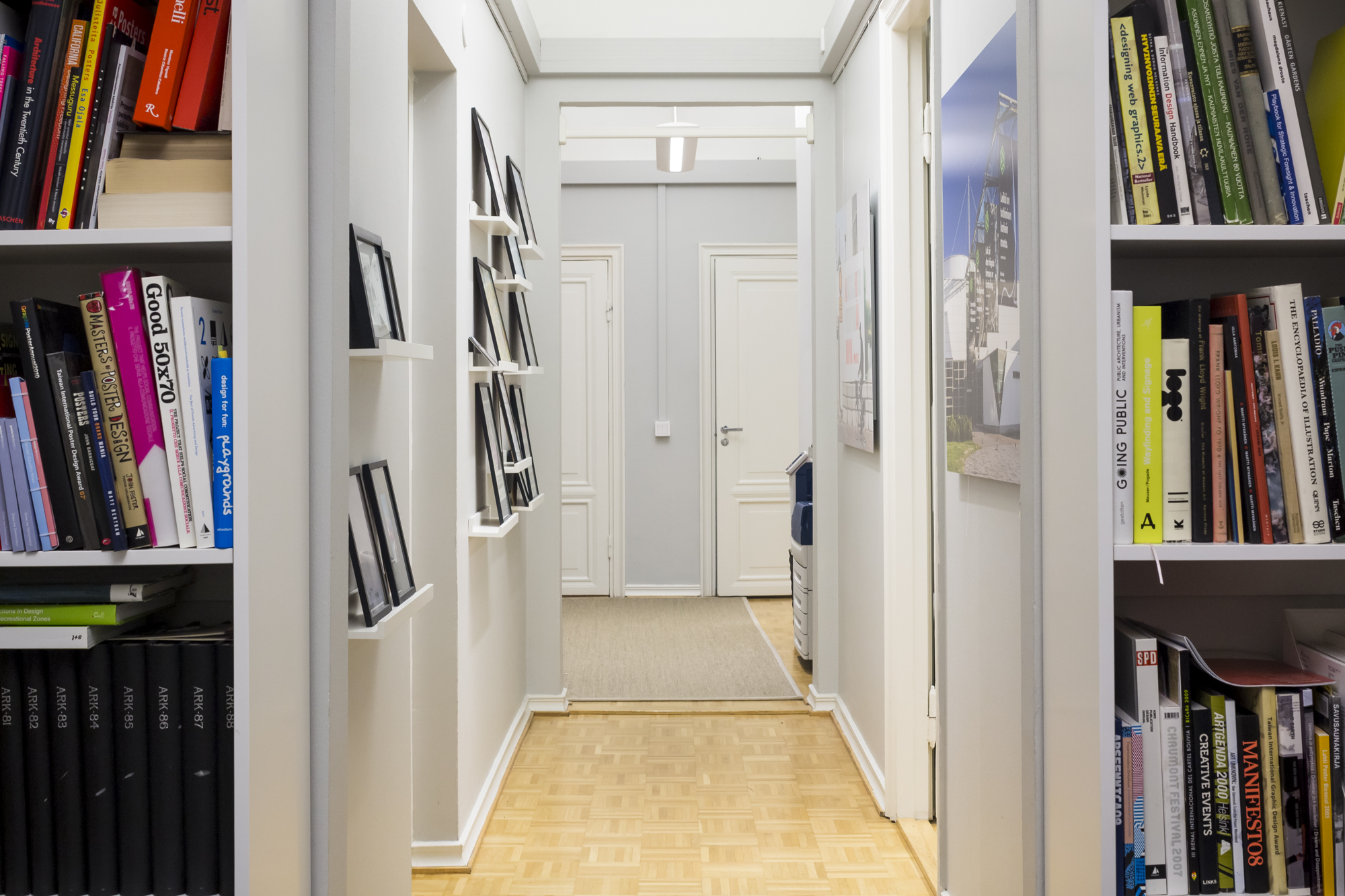Weekly Studio: Berry Creative

Having recently helped Messukeskus celebrate their 100th anniversary with a 25-metre-long glowing red slide, Timo and Kaisa Berry talk to Weekly Studio about a lifetime spent developing a studio that uniquely combines business and graphic design with environmental art.
Having recently helped Messukeskus celebrate their 100th anniversary with a 25-metre-long glowing red slide, Timo and Kaisa Berry talk to Weekly Studio about a lifetime spent developing a studio that uniquely combines business and graphic design with environmental art.
Let’s talk about the large interactive sculpture you recently completed for Messukeskus. How did that come about?
Timo Berry: We’ve been working with branding and strategic design for years, but our other strong area is environmental art as that’s Kaisa’s background. Messukeskus approached us with the idea for an artwork to celebrate their 100-year anniversary, as we had previously created an installation of umbrellas for the same client.
Kaisa Berry: The umbrellas were a very successful installation for Habitare 2015, so we already had a relationship with Messukeskus. And actually there’s Messukeskus, but there’s also the Messukeskus foundation, who initiated the project. Messukeskus’s front yard is uninspiring and the idea behind the commission was to make the space come alive by installing an artwork.
And did they give you a specific brief?
Timo: It was a very open brief. Customers are rarely accustomed to buying art, and whether we define our work as design or art isn’t so crucial in this instance, but we proposed to walk them through some questions related to their mission, strategy and business goals.
Kaisa: In addition to their central mission, Messukeskus also want to bring people together to meet each other and to have shared experiences and these issues also underpinned our idea.
Timo: They didn’t quite know what they wanted, so we walked them through a strategic workshop to go through their mission and strategy as a means of reaching the right target. We didn’t just create a piece of art. Through those workshops, we dug down to what our customer really wanted to achieve with the piece and from that we arrived at the final project.
Kaisa: We actually made three different concepts. We had several ideas of what kind of approach or form would work best in the location and then they selected one.
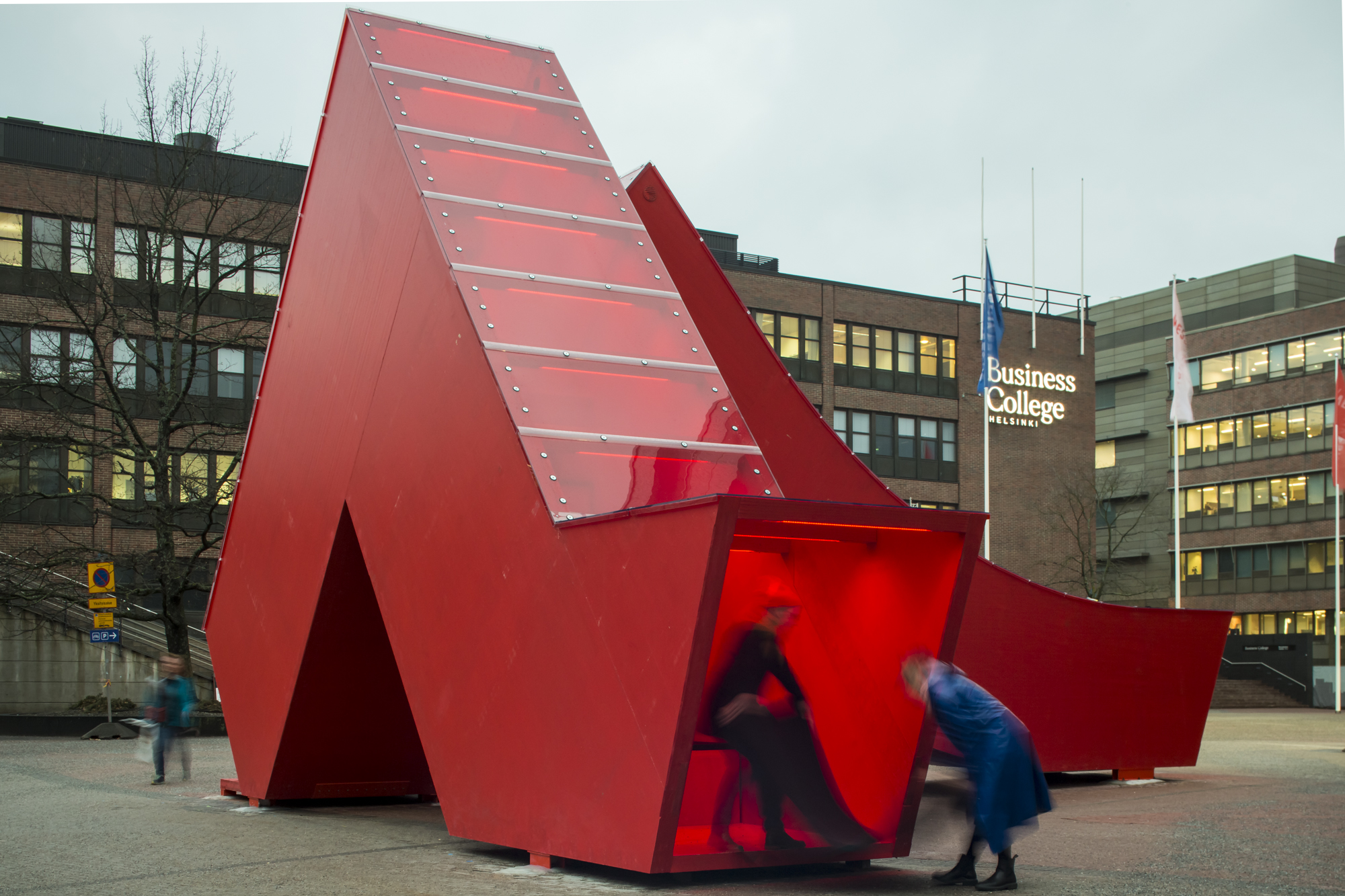
Do you think part of the reason they commissioned you as opposed to a sculptor, for example, was because they wanted this strategic analysis as much as an artwork?
Timo: I think strategy is such a slippery word, but it’s really a question of clarifying what the customer needs. And that is something that designers do better than artists. For example, we do a lot of business design so we have a set of tools we can walk through with our customers. When we start asking these questions, the customer often realises that we can help them clarify what they really need. That’s usually where our commissions come from.
I engage with artists, architects and designers, but it’s always the designers and architects who are clever about finding ways to expand their original brief.
Timo: We talk about this a lot together because we work with art, we’re officially ”artists”, we’re members of the Association of Finnish Sculptors, but our backgrounds are more firmly in design. I think that the biggest difference is in the mind-set, in that artists are often trained – Kaisa can disagree with me here – to express themselves and designers are taught to understand and then serve the customer’s needs.
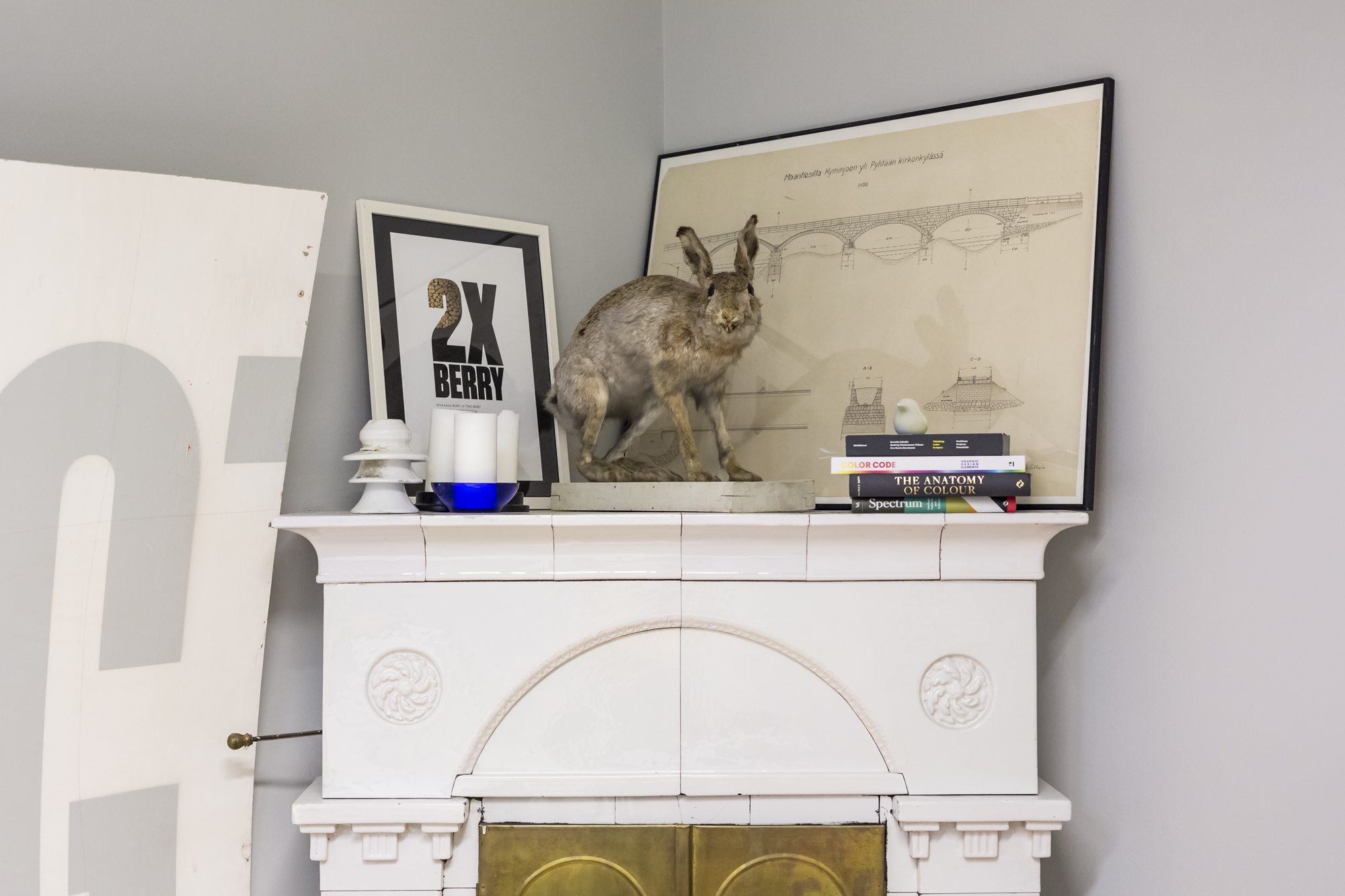
I’m curious about these two distinct branches of your office, the more traditional design side which covers graphics and identity and the side more concerned with environmental art and landscape. Is this diversity strategic or simply a reflection of your interests? And has such diversity helped or hindered in terms of obtaining clients?
Kaisa: When we started out we had two different parts which were quite separate. I worked on environmental art and Timo worked on graphic design. In our current office, everything is much more closely connected and I think we really benefit from the crossover. And although, if you look at our website for example, it may seem as if we’re trying to do everything, we really don’t. We actually have quite a clear understanding of which projects are for us and which aren’t. But in general, I think that our employees also appreciate that they can be involved in crossover projects. For example, our graphic designers are often involved in environmental art projects.
Timo: To answer your question about whether the diversity is a problem, I’d say yes and no. A customer who wants a very particular outcome would steer clear of us, unless that outcome was environmental art, magazine design or a branding project. If there’s a customer who wanted a very particular ready-made solution, then we are not the right people to come to. On the other hand, I think we’ve been able to attract customers who are aware that you shouldn’t jump so quickly to a solution, but really look into a problem first.
Over the years, we’ve developed a business design framework that we work through with customers that looks at their mission, their successes and their people. Only after going through these processes is it meaningful to start talking about designing solutions. If we get a customer who only wants one piece of the solution, be it a new website or logo, and is unwilling to go through the burden of these processes, then they probably aren’t the right customer for us. But to be honest, I’m the analysis-guy, and Kaisa is the intuitive artist.
Kaisa, you mentioned that you have enough experience now to know which projects are and are not for you. Could you give an example of the sort of project that would definitely not be for you?
Kaisa: Firstly, I would say that the framework Timo described is the ideal, and bringing it to the art field is not straightforward. We were able to go through it with Messukeskus, but we don’t always get to even though it’s how we would prefer to work. But to give an example of the kind of thing we don’t do, we don’t produce events (of happenings). We’re an office of 10 people and we know what we can do well and big parties isn’t one of them.
Timo: I would say that it’s more down to the attitude of how the customer looks at the world, rather than any particular field or project that we wouldn’t like to work on. We like to collaborate and build teams per project when necessary.

And how have you developed these frameworks?
Timo: For me, it’s been a constant learning process. As a designer, I was taught to think about colour and form, but also to think that I know better than the customer; that as a designer, it’s me who has the vision and not the customer. I was always curious about what designers based this position on. I also pick up ideas as I go along. LinkedIn is my preferred forum, which sounds strange for a designer, but there’s so much useful information disseminated there.
Kaisa: One of our strengths is that, although Timo loves analysis, we also think a lot about how something feels and whether it has an emotional and physical impact. We’re very attentive to both aspects of design.
You’ve been working together as Berry Creative since summer 2017. What prompted you to set up the new agency?
Kaisa: Timo had a previous company where I also worked, but my projects were quite separate from graphics and strategy. From 2017, we’ve really brought everything together to work across disciplines.
Timo: We’ve been working on projects since our university days where we made environmental art pieces together. So, we’ve been doing this now for some twenty years, it’s just that the commissions have grown in scale and there’s money involved.
Kaisa: I have also taught part time at Aalto as a lecturer and students often ask me how we get such interesting commissions. My answer is that for the first ten years, we paid for materials ourselves and sought permission to, for example, install something in a park. There was no money involved, just expenses. Along the way, we started getting small grants to cover materials until one day, there was a breakthrough and we started to earn some money. But we worked for free for quite a long time before any of that happened.
Timo: The main thing is that we’re both driven by curiosity more than by business and we do pretty well considering. But our studio is really the fruit of our curiosity, which is the driving force.
So, the agency is just the latest development in this particular stage of your careers?
Timo: More or less, yes.

Do you see it as a good framework for the kinds of projects you want to be doing or do you think there could be a change five years down the line?
Kaisa: For me, there’s so much to be done and we couldn’t do projects this size if we worked alone. Having a team framework is really useful when you want to work on large scale projects.
Timo: My hope is to grow our understanding of what we’re doing, our customers and end users, and the context we’re working in and then build a bigger team that knows how to better answer these questions in order to go beyond our current skill level. It’s an adventure.
What projects are you working on at the moment?
Kaisa: We have some interesting, larger-scale area development projects going on where we are tying together branding, landscape architecture and environmental art which is really exciting.
Timo: Also looking at the social culture of the area and how to build social culture which is so interesting.
Kaisa: We have many commissions which are under construction right now and this autumn has been especially busy. I’m visiting construction sites all the time. There are a lot of projects which are going to be completing soon.
Timo: We’re helping a few customers with strategic branding and doing customer magazines. I’ve also got a stamp on my hands I should finish. So, many different things.
Let’s talk about your studio space and working culture.
Kaisa: We have 250 square metres, but we use just over half of that for our studio. We also have an architect’s office, a research company, a freelance type designer, a couple of communication specialists and a web developer working here. We’ve tried to attract certain people and fields who aren’t necessarily in our company, but with whom we have strong links.
Timo: It’s easier to exchange and test ideas when you’re all sharing the same space. So, we really work on finding the right team even if they aren’t under our company umbrella.
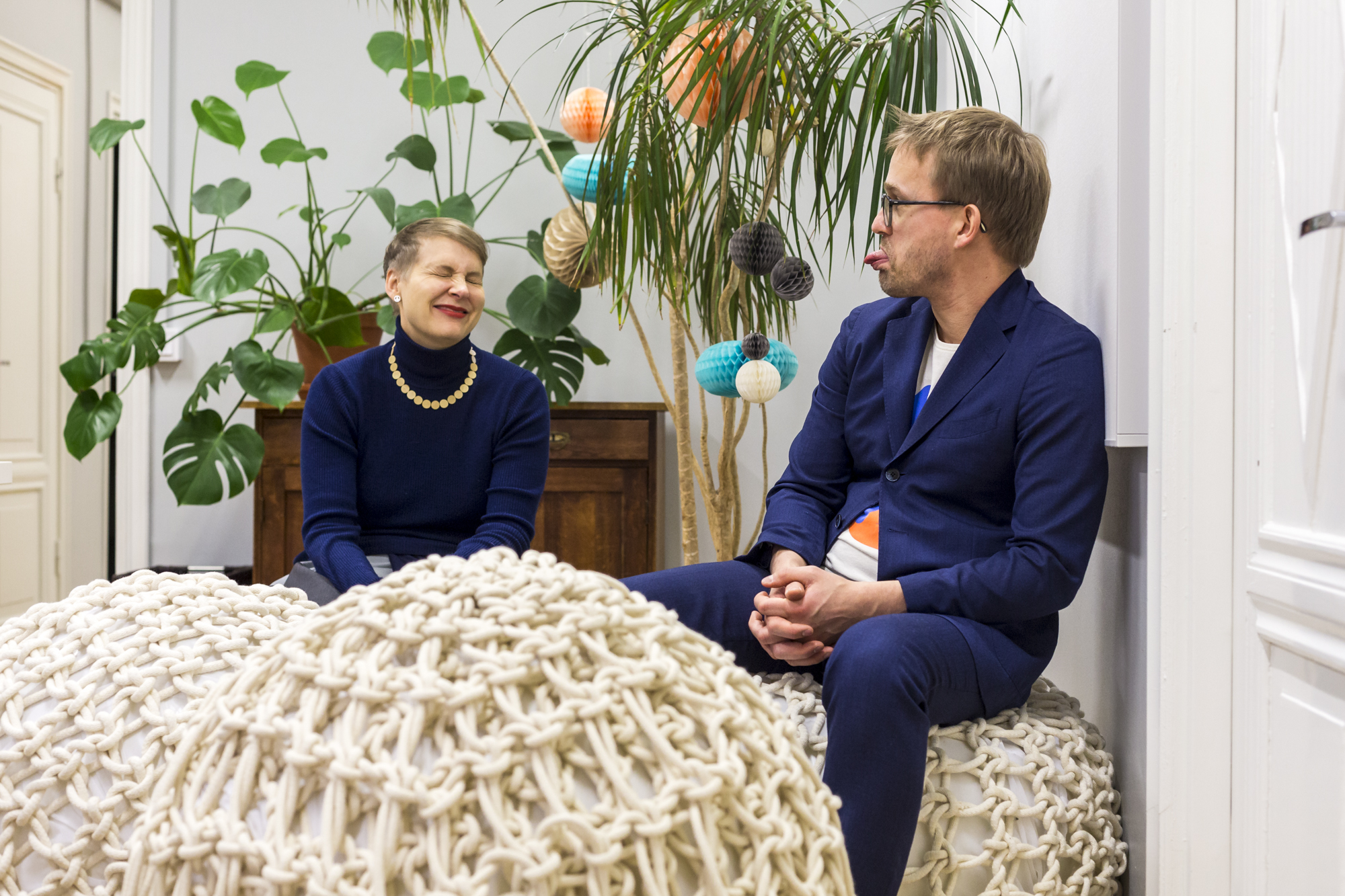
And are you chatting to each other daily or more on a project-by-project basis?
Timo: We say hello and share coffee together daily.
Kaisa: And have lunch together, too.
Timo: That way, when we have a customer problem, it’s very easy to ask someone to take a look and offer insight. Things might then develop further from there.
Kaisa: Our studio kitchen is like a home kitchen and often we have ten people around the table all having lunch together. And, although I do like our current studio, in the future my dream would be to have a rougher industrial space where we could have more space for really doing and making things.
I was going to ask whether you have a workshop.
Kaisa: We do make prototypes, but we can’t do any woodwork in the studio.
Timo: We can’t cast concrete, either. Mainly, we work with cardboard here.
Where do you do messy work?
Timo: In our yard at home.
It’s funny how work always tends to bleed into home life even when you have a 250 sq m office space!
Kaisa: We did, for example, the testing for the ceilings of the Messukeskus installation in our yard at home.
Timo: We have all the power tools at home, so if we need to construct things we tend to do them at home, but it would be wonderful to have a shop at the studio. Then, I’d never want to go home except for the kids.
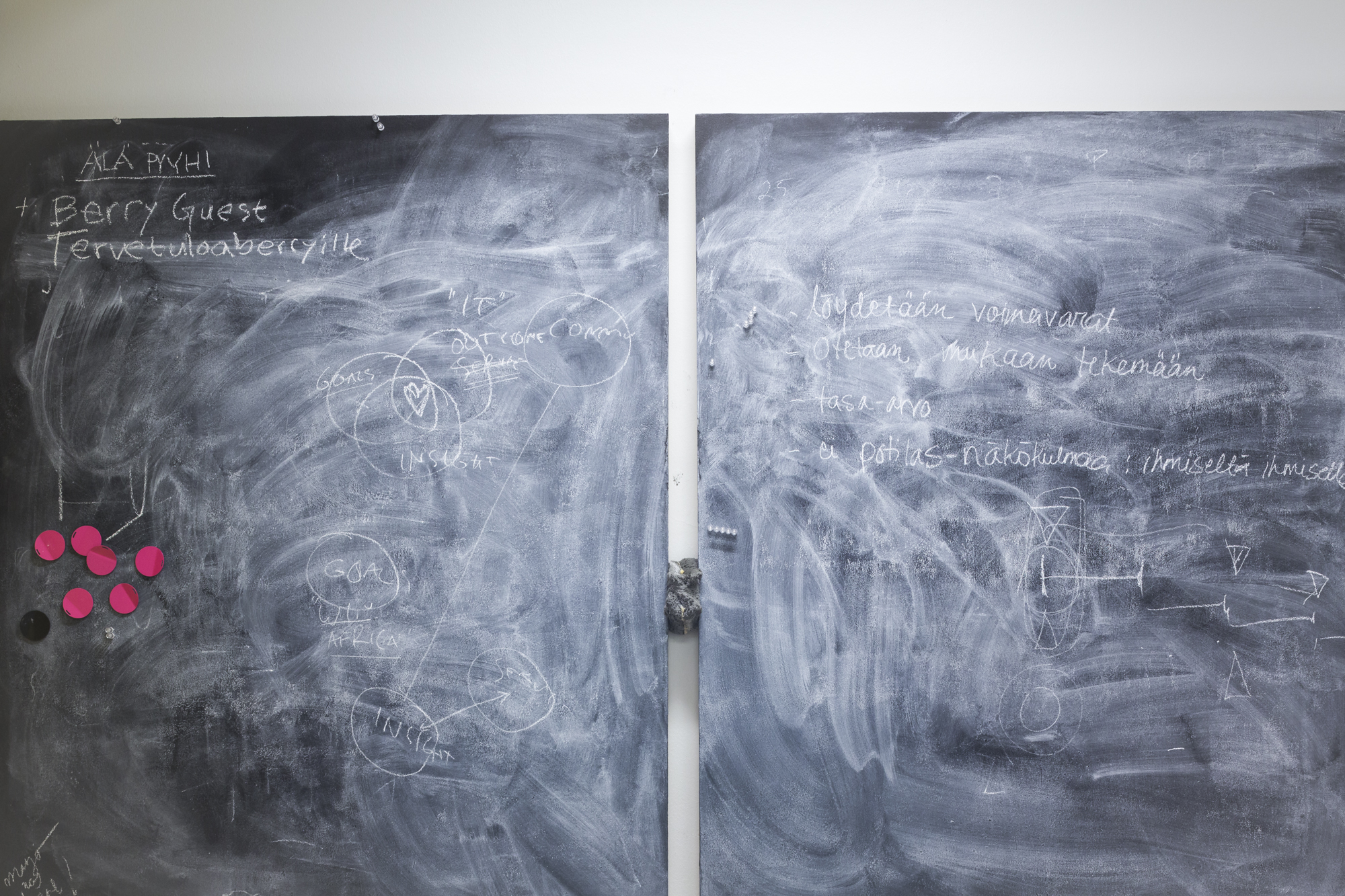
Something else I wanted to pick up on, Kaisa, was about your teaching at Aalto. Does this feed into your professional work or is it quite separate?
Kaisa: The reason why I’ve been willing to teach is because it’s a wonderful way to keep abreast with what’s going on with how young people think. It’s also a very good way to find staff for the office! Timo teaches himself through reading a lot, but I often attend lectures at the University so it’s a good resource for keeping up with things generally.
Timo: Teaching is such a good way of learning because it forces you to clarify your own thinking in order to share it with others.
You both seem to have a very strong dedication to lifelong learning.
Kaisa: Absolutely. I’m a learner, really. We’re learning and studying all of the time.
Timo: Curiosity really is a driving force for both of us.
Finally, could you reflect more generally on how the broader climate has evolved in Finland since you started working both in terms of the industry but also in terms of how clients understand the work.
Kaisa: For one thing, there’s so much happening in Helsinki and in Finland at the moment. The climate in which we’re working is really inspiring and I feel that we’re being heard.
Timo: Something I find gratifying is that our customers are really tapping into different sources and frameworks which is opening their eyes to new ideas. Instead of just asking for a brand magazine, for example, they are more willing to understand first what it is that they need and then exploring a number of different options. There’s an openness to considering more creative solutions. But although things are changing, there’s also still some work to do. For example, we were included in a magazine last year featuring a bunch of designers, ‘Design Year 2018’. It has sections for interior designers, textile designers, chair designers and so on. We appear at the very end because we are filed under the section ‘others’. For us, there’s something wonderful about being listed as ‘other’ because it’s never about whether you’re designing chairs or textiles or branding, but always about the impact you’re trying to create for the customer and for the end user.
